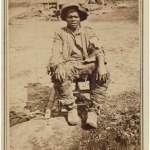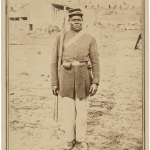The racial violence that swept Memphis in early May 1866 was no accident. Indeed, very little happens in a vacuum: not wars, not revolutions, not even the sinking of the Titanic. Histories, it turns out, have their own histories, and one of the historian’s tasks is to figure out why things happened. Contextually Speaking raises this question with respect to Memphis and invites viewers to come along as we work to understand why it was that violence swept Memphis, why it took place in May 1866, and why it was that the mob paid special attention to black soldiers, their families, and the churches and schools that served the black community. In developing our understanding of the larger context of Civil War and Reconstruction America, we will deepen our understanding of the Memphis Massacre. This column will appear at regular intervals on our blog, advertised through our Twitter feed and Facebook page, and reprinted on our Resources page.
Throughout American history, military service has been seen as the one of the highest forms of citizenship. To lay one’s life on the line for the protection of one’s country has been both an honor and a responsibility. In this country, military service has long been seen not only as a symbol of citizenship, but manliness too. This was especially true in the Civil War era. Regardless of the side one fought on, soldiering was understood as one of the most honorable and selfless acts of masculine citizenship. Indeed, there was a real sense that soldiering confirmed on men the full spectrum of civil and political rights: you became a full citizen through military service.
These ideas were deeply embedded in American culture, so much so, that many Northerners were initially dubious about the ability of black men to make competent soldiers. Could they fight? Would they fight? Engagements at Milliken’s Bend and Port Hudson, Louisiana; at Fort Wagner, South Carolina, and elsewhere, soon proved the doubters wrong. Black men made very good soldiers. And as was the case with Americans more generally, those soldiers believed that their service under arms to their country opened up to them access to the same rights and privileges enjoyed by white men.
As Frederick Douglass famously said,
Once let the black man get upon his person the brass letter, U.S., let him get an eagle on his button, and a musket on his shoulder and bullets in his pocket, there is no power on earth that can deny that he has earned the right to citizenship.
But not every American was comfortable with the idea of black men earning the rights of citizenship through military service, and some of the most vociferous opponents of black soldiers were those who had once been slaveholders. In their eyes, there was nothing noble about a black man in uniform. Instead, what they saw were dangerous and subversive influences: blue-clad symbols not only of Federal power, but of a world turned upside down. This view led the Confederate government to treat captured black federal soldiers not as prisoners of war, but rather as escaped and rebellious slaves.
White southerners’ doubts and fears of black soldiers followed them beyond Appomattox. Those proud men with the eagles on their buttons, muskets on their shoulders, and bullets in their pockets set an example that terrified many ex-Confederates, especially those who yearned for nothing more than to keep former slaves in positions of subordination: as menial workers who knew not to complain or demand fair treatment and just wages, as a people who knew not to strive for the rights of a citizen.
Because of the larger cultural and political meanings attached to soldiering, black men in blue uniforms often found themselves targets of post-emancipation violence. Those who were assigned to duty at the federal garrison in Memphis were no exception. As archival evidence reveals, they suffered the wrath of former Confederates long before mobs took to the streets of Memphis in May 1866. Joe Brown, a black sergeant on duty with the federal garrison at Memphis, was one of those men who was discovered that his uniform made him a marked man in some people’s eyes. Read here for Sgt. Brown’s own account of what happened after a disgruntled white Memphian espied him sitting quietly in his doorway on the night of September 10, 1865: Statement of a Tennessee Black Sergeant.

